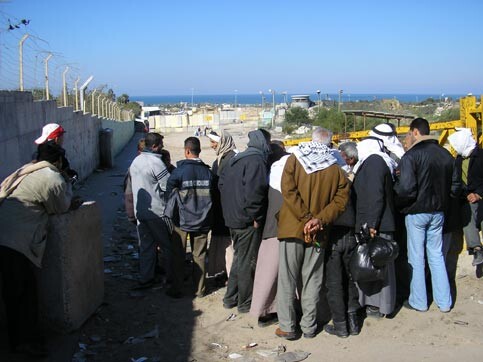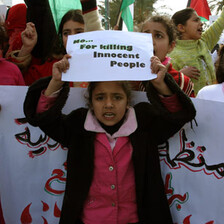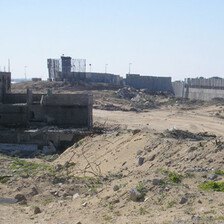
Palestinians waiting for the checkpoint at Muwasi, located between the sea and the Gush Katif settlement block. In this corner of the Gaza Strip some 6,000 Palestinians live completely cut off from the outside world. (Arjan El Fassed)
When Alexander the Great reached the southeast Mediterranean he encountered resistance along the coast of what is now Israel. To deter any other rebellious towns he crucified 2,000 men, and from that point town after town surrendered to him unconditionally.
Then he reached Gaza. The local population made it clear that he was unwelcome and began an intense military campaign against him. Eventually, as many people in Gaza will happily remind you, Alexander left having contracted the disease that would eventually kill him.
There have been many subsequent invasions – Napoleon, the Ottomans, the British – in this narrow strip of territory into which 1.4 million Palestinians and 8,000 Israeli settlers are now squeezed.
The two sides of present-day Gaza are the poverty-stricken Palestinian population and the Israeli settlers who control about 45% of the land. But neither population is united; the divisions within each are as real as those between them. And the Israeli soldiers present in numbers to protect the settlers are now charged with overseeing their withdrawal - and if necessary, eviction - by August.
The settlers have initiated an effective grassroots campaign across Israel to protest against the withdrawal plan of their prime minister, Ariel Sharon. They have widely distributed their orange ribbon symbol, and plastered the highways and byways of Israel with posters labelling Sharon a traitor. Some of their more virulent tactics have come in for heavy criticism; nine Israeli generals, whose parents survived the Nazi holocaust, expressed their disgust at attempts by some settlers to link the removal of settlements with that catastrophe.
The settlers are far from homogeneous. They include religious Zionists from Hebron, growing in numbers in the southern part of the Gaza settlement blocs, who believe that disengagement is a denial of the will of God; but there are also social-welfare recipients with their bags packed, who are ready to go upon payment of substantial compensation packages.
The scenes of settlers attacking Israeli soldiers and stoning Palestinian civilians have shocked official Israel. Israeli commentators have been quick to state that this uncovers the truth of settler behaviour inside the West Bank and Gaza strip for years. Even hardcore settlers in the Gush Katif bloc of settlements southern Gaza publicly question why the Israeli military allowed these even more right-wing settlers into the strip.
Two polarised peoples
The Palestinian civilian population exist around, but subjugated to, these settlers, in Gaza’s dense and decayed refugee camps. Among them there also exists a huge variety of opinions and attitudes to disengagement. Armed groups such as Hamas are keen to prove that this is an Israeli withdrawal under fire; when the moment comes they may be unable to resist the opportunity to fire their crude home-made rockets into the settlements – perhaps when they are likely to inflict maximum casualties for maximum publicity.
Alongside them are Palestinian NGOs who agree with Dov Weisglass, chief Sharon adviser, that disengagement will be “formaldehyde” for a Palestinian state – “liquid in which dead bodies are preserved.” Somewhere in the shadows is the shaken Palestinian National Authority – a body with little political or institutional authority after the years of destruction following the outbreak of the second intifada in 2000.
Amidst this diversity, there is a rare unity between groups like Hamas and the Israeli settlement movement over the disengagement plan. Each side insists, albeit in the terms of their own language, that Israel is retreating because of military failure. Palestinian civil society’s views coincide remarkably with those of Dov Weisglass in believing that disengagement is a momentous setback for Israel.
But such surface agreement belies the substantial divisions between Israelis and Palestinians that are being cemented by physical separation (it is illegal for Israeli citizens to enter the “occupied territories” and virtually impossible for Palestinians to enter Israel). The polarisation between the two peoples is being institutionalised, making communication with and understanding of the “other” an even more remote prospect.
Palestine by the sea
One of the few certainties of the plan is that as a result of an agreement brokered by the United States, the institutional fabric of the settlements will be destroyed by the Israeli military. The fate of the settlements causes alarm on both sides: the Israelis worry about a public-relations disaster if it demolishes homes the Palestinians badly need, while the Palestinian National Authority fear that the settlements’ well-appointed homes would be seized by unruly elements in a way that would tarnish its fading authority and do little to alleviate Gaza’s extraordinarily acute housing crisis.
But what will come next? A long-term suggestion floated in the international community is to build a tourist-friendly “Costa-del-Gaza”. The rumour that the special envoy James Wolfensohn may secure a deal to build a port connecting Gaza and Egypt, and even an underground trench linking Gaza to the West Bank, may support this. But even if the reality that such construction is about institutionalising war rather then constructing peace is ignored, it is not clear that such plans will meet Gaza’s essential needs: for economic investment, work, and – more then anything – housing.
The sheer lack of horizontal space to build on, a growth rate that on current trends will double Gaza’s population every eighteen years, and an Israeli military policy of house demolitions (1,200 homes in 2004 alone, according to the Palestinian Centre for Human Rights) contribute to this severe crisis.
The value of land in Gaza, in financial and status terms, is colossal. Land is the prize of the wealthy, the powerful and the connected. Most refugees in Gaza, who are financially and socially excluded, feel a sense of dislocation from land. Some are reluctant to own land because of national sentiment; they believe they will one day return to their family lands inside what became (after the 1948 nakba) the established state of Israel. Most others are simply too poor to own land and will benefit substantially if the land inside the former settlement blocs can be converted into high-rise, low-cost housing.
The symbolic opportunity for thousands of Palestinians to reclaim land, parts of which they have had no access to since 1967, and to live on this land, is highly significant. The land where the settlements lie stretches along much of Gaza’s magnificent coastline; Israeli surfers have prized it for years for its hospitable waves and sandy beaches.
But Palestinian civilians living in Gaza heard all this talk of “Costa-del-Gaza” and newfound freedoms during the Oslo process. The European Union and other donors poured money into the Gaza strip to the extent that it become the most aid-funded place per capita in the world. Yet only a few years later the Oslo process, now almost completely exhausted, erupted into the second, al-Aqsa intifada. The clear failure to end the Israeli occupation and to include essential and basic human rights into the peace process can be attributed to Oslo’s failure and the violence that ensued.
There may be a repeat of this pattern in the coming years. Gaza may well be transformed into an area packed with concrete towers housing desperate Palestinian families with some select beach hotels and surfing facilities. This is a prospect that many Palestinian and international civil-society activists view with trepidation. Some families will welcome the housing, the access to the sea, possible associated income and living-space; but once the euphoria wears off most Palestinians will realise that what Israeli human rights organisations B’tselem and Hamoked call “one big prison” will have become an even bigger prison than before. For the security of Palestinians and Israelis alike this would sow not the seeds of peace but the seeds of further tragedy.
Eoin Murray is an Irish Human Rights worker, based in Gaza City. He is researching on the position of Human Rights Defenders in the occupied territories for Front Line, the International Foundation for the protection of Human Rights Defenders. This article was first published on openDemocracy on July 4, 2005 and reprinted on EI with permission.
Related Links





